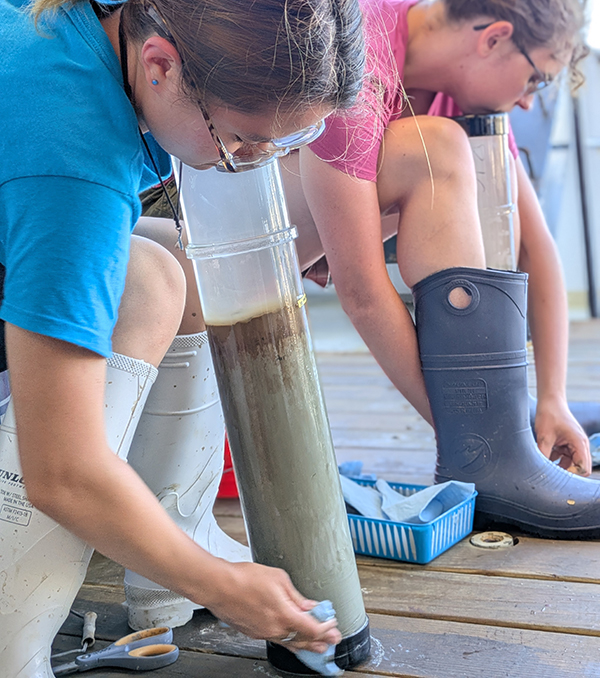Global negotiators prepare for major UN treaty talks to curb plastic waste – ehn.org

Report on the Proposed Global Plastics Treaty and its Alignment with Sustainable Development Goals
Introduction: The Imperative for a Global Plastics Treaty
As United Nations member states prepare for negotiations on a global plastics treaty, experts are urging swift action to address the escalating crisis of plastic pollution. The proposed treaty aims to establish a legally binding international framework covering the entire lifecycle of plastics, from production to disposal. Without significant intervention, current projections indicate a doubling of plastic pollution by 2050, posing a severe threat to global sustainability efforts.
The Impact of Plastic Pollution on Sustainable Development
Unchecked plastic production and waste present a multifaceted threat that directly undermines several Sustainable Development Goals (SDGs):
- SDG 14 (Life Below Water) & SDG 15 (Life on Land): Plastic waste permeates all ecosystems, causing suffocation and harm to marine and terrestrial life. The breakdown of plastics into microplastics leads to widespread environmental contamination.
- SDG 3 (Good Health and Well-being) & SDG 6 (Clean Water and Sanitation): Microplastics have infiltrated food chains, drinking water sources, and the air. The chemicals contained in many plastics are linked to significant health risks, including hormone disruption and long-term diseases.
- SDG 13 (Climate Action): The production of plastics is a major contributor to greenhouse gas emissions. Projections estimate that plastic production could triple by 2060, exacerbating climate change.
- SDG 11 (Sustainable Cities and Communities): Existing waste management systems are overwhelmed by the volume of plastic waste, particularly in urban centers.
Treaty Objectives and Contribution to the 2030 Agenda
The proposed treaty seeks to establish a coordinated global response by focusing on several key objectives that align with the 2030 Agenda for Sustainable Development:
- Reduce Virgin Plastic Production: This primary objective directly supports SDG 12 (Responsible Consumption and Production) by addressing the root cause of plastic pollution and promoting a circular economy.
- Establish Global Standards: The creation of universal standards for recycling and the elimination of problematic and harmful materials will advance SDG 12 and protect human health, in line with SDG 3.
- Finance Waste Management Upgrades: The treaty aims to create financial mechanisms to support the enhancement of waste management infrastructure, a critical component for achieving SDG 11 (Sustainable Cities and Communities) and fostering international cooperation under SDG 17 (Partnerships for the Goals).
Conclusion: A Coordinated Global Response
The global plastics treaty represents a landmark opportunity to confront the plastic crisis from a “cradle-to-grave” perspective. Its successful negotiation and implementation are essential for:
- Establishing a critical global partnership, fulfilling the ambition of SDG 17.
- Treating plastic pollution as a planetary emergency alongside climate change.
- Making significant progress across a range of interconnected Sustainable Development Goals, safeguarding both human and environmental health for future generations.
Sustainable Development Goals (SDGs) Addressed in the Article
1. Which SDGs are addressed or connected to the issues highlighted in the article?
- SDG 3: Good Health and Well-being: The article highlights the health risks associated with plastic pollution, mentioning that “chemicals in many plastics pose poorly understood risks to human health, from hormone disruption to long-term disease” and that microplastics are found in “drinking water.”
- SDG 6: Clean Water and Sanitation: The presence of microplastics in “seafood, drinking water, and even the air” directly connects to the goal of ensuring clean water sources, which are being contaminated by plastic waste.
- SDG 11: Sustainable Cities and Communities: The article points to the pressure on “waste systems already overflowing” and the need to “finance waste management upgrades,” which are key components of sustainable urban living.
- SDG 12: Responsible Consumption and Production: This is a central theme. The article focuses on a treaty to address the “full lifecycle” of plastics, “reducing virgin plastic use,” setting “global standards for recycling,” and “eliminat[ing] problematic materials,” all of which are core to responsible production and consumption patterns.
- SDG 13: Climate Action: The connection is explicitly made, stating that unchecked plastic production is “driving up greenhouse gas emissions” and that plastic pollution should be treated as a “planetary emergency alongside climate change.”
- SDG 14: Life Below Water: The article directly addresses this goal by stating that “Marine life is suffocating in plastic debris” and that microplastics are contaminating “seafood.”
- SDG 17: Partnerships for the Goals: The entire context of the article, which is about “United Nations member states” negotiating a “global plastics treaty,” exemplifies a global partnership to tackle a shared environmental challenge.
2. What specific targets under those SDGs can be identified based on the article’s content?
- SDG 3: Good Health and Well-being
- Target 3.9: By 2030, substantially reduce the number of deaths and illnesses from hazardous chemicals and air, water and soil pollution and contamination. The article’s mention of “chemicals in many plastics” posing risks of “hormone disruption to long-term disease” directly relates to this target.
- SDG 6: Clean Water and Sanitation
- Target 6.3: By 2030, improve water quality by reducing pollution, eliminating dumping and minimizing release of hazardous chemicals and materials. The discovery of microplastics in “drinking water” makes this target highly relevant.
- SDG 11: Sustainable Cities and Communities
- Target 11.6: By 2030, reduce the adverse per capita environmental impact of cities, including by paying special attention to air quality and municipal and other waste management. The article’s focus on “waste systems already overflowing” and the need to “finance waste management upgrades” aligns with this target.
- SDG 12: Responsible Consumption and Production
- Target 12.4: By 2020, achieve the environmentally sound management of chemicals and all wastes throughout their life cycle…and significantly reduce their release to air, water and soil. The proposed treaty’s aim to address the “full lifecycle” of plastics “from cradle to grave” is a direct reflection of this target.
- Target 12.5: By 2030, substantially reduce waste generation through prevention, reduction, recycling and reuse. The treaty’s goals to “reduc[e] virgin plastic use,” set “global standards for recycling,” and “reduc[e] pollution from production through disposal” are central to this target.
- SDG 13: Climate Action
- Target 13.2: Integrate climate change measures into national policies, strategies and planning. The proposed “global plastics treaty” is a policy instrument that addresses a source of “greenhouse gas emissions,” thereby integrating climate considerations into global environmental policy.
- SDG 14: Life Below Water
- Target 14.1: By 2025, prevent and significantly reduce marine pollution of all kinds, in particular from land-based activities, including marine debris. The statement that “Marine life is suffocating in plastic debris” makes this target a primary focus of the article.
- SDG 17: Partnerships for the Goals
- Target 17.16: Enhance the global partnership for sustainable development…to support the achievement of the sustainable development goals in all countries. The negotiation of a “binding UN treaty” among member states, scientists, and industry leaders is a clear example of such a global partnership.
3. Are there any indicators mentioned or implied in the article that can be used to measure progress towards the identified targets?
- Amount of plastic pollution: The article implies this as a key indicator by quoting a projection that “business as usual will take us to a 2050 where we double the amount of plastic pollution on our planet.” Reducing this amount is a measurable goal.
- Rate of plastic production: Progress can be measured against the projection that production is “set to triple by 2060 if unchecked.” A key indicator would be the reduction in the growth rate of plastic production, especially “virgin plastic.”
- Greenhouse gas emissions from the plastics industry: Since the article links plastic production to “driving up greenhouse gas emissions,” tracking these specific emissions would be an indicator of progress.
- National recycling rates: The goal to set “global standards for recycling” implies that national and global recycling rates would be a primary indicator for measuring the treaty’s success.
- Level of financing for waste management: The mention of the need to “finance waste management upgrades” suggests that the amount of capital invested in these systems, particularly in developing nations, is a tangible indicator.
- Existence of a ratified global treaty: The successful negotiation and ratification of the “binding UN treaty” itself serves as a critical indicator of global cooperation and commitment (Target 17.16).
Summary Table of SDGs, Targets, and Indicators
4. Create a table with three columns titled ‘SDGs, Targets and Indicators’ to present the findings from analyzing the article. In this table, list the Sustainable Development Goals (SDGs), their corresponding targets, and the specific indicators identified in the article.
| SDGs | Targets | Indicators (Mentioned or Implied in Article) |
|---|---|---|
| SDG 3: Good Health and Well-being | 3.9: Reduce illnesses from hazardous chemicals and pollution. | Reduction in human exposure to harmful plastic-related chemicals. |
| SDG 6: Clean Water and Sanitation | 6.3: Improve water quality by reducing pollution. | Levels of microplastics in drinking water sources. |
| SDG 11: Sustainable Cities and Communities | 11.6: Reduce the environmental impact of cities, including waste management. | Amount of financing for waste management upgrades; reduction in overflowing waste systems. |
| SDG 12: Responsible Consumption and Production | 12.4: Environmentally sound management of chemicals and wastes. 12.5: Substantially reduce waste generation. |
Reduction in virgin plastic production; establishment of global recycling standards; national recycling rates. |
| SDG 13: Climate Action | 13.2: Integrate climate change measures into policies. | Amount of greenhouse gas emissions from the plastic production lifecycle. |
| SDG 14: Life Below Water | 14.1: Prevent and significantly reduce marine pollution. | Total amount/volume of plastic pollution on the planet; amount of plastic debris impacting marine life. |
| SDG 17: Partnerships for the Goals | 17.16: Enhance the global partnership for sustainable development. | Successful negotiation and ratification of the binding global plastics treaty. |
Source: ehn.org

What is Your Reaction?
 Like
0
Like
0
 Dislike
0
Dislike
0
 Love
0
Love
0
 Funny
0
Funny
0
 Angry
0
Angry
0
 Sad
0
Sad
0
 Wow
0
Wow
0














































































